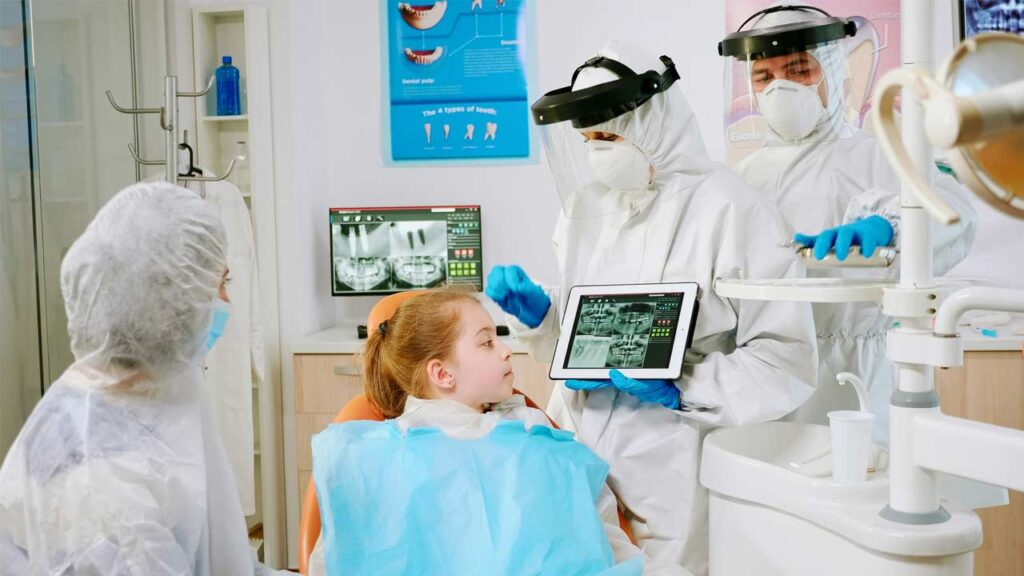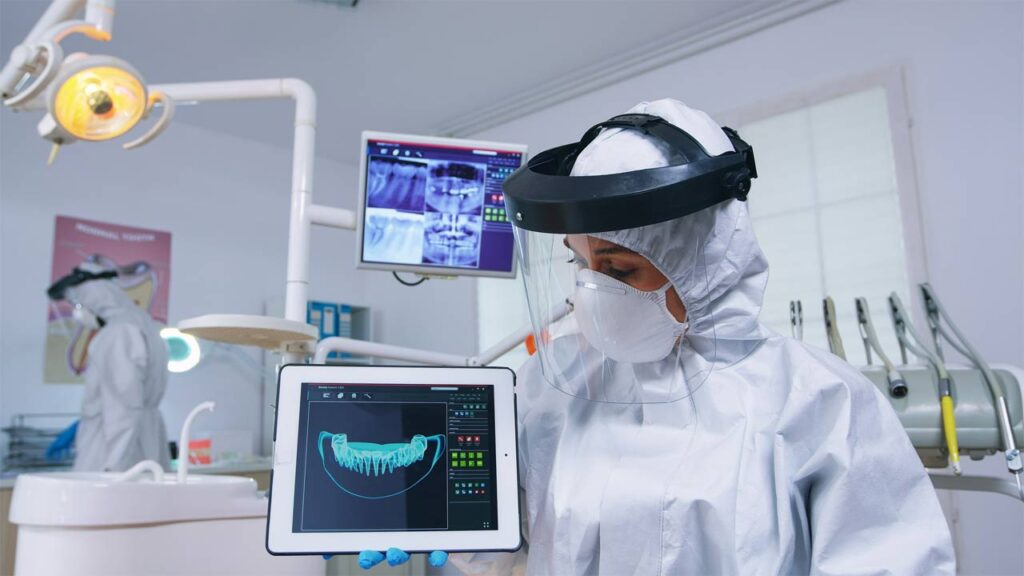Dental technology has come a long way over the years, and it is now an integral part of modern dentistry. With advancements in technology, dentists are now able to provide patients with more efficient, comfortable, and accurate treatments.
In this blog, we will delve into the various aspects of dental technology, including the types of technology used, the advantages they bring, and the impact they have on patient experience and clinical outcomes.
Dental Technology in Practice
A. Types of Technology Used in Dentistry

There are many different types of technology used in dentistry today, ranging from diagnostic tools to treatment options. Some of the most common types of dental technology include:
- Digital X-rays: Digital X-rays produce images that are clearer and more detailed than traditional X-rays. They also emit less radiation, making them safer for patients.
- Intraoral cameras: Intraoral cameras are small, handheld cameras that allow dentists to take high-resolution images of a patient’s mouth. These images help dentists to diagnose and treat dental issues more accurately.
- Dental lasers: Dental lasers are used for a variety of procedures, including gum surgery, cavity treatment, and tooth whitening. They offer several advantages over traditional methods, including less pain, less bleeding, and faster healing times.
B. Advantages of Using Technology in Dental Procedures
The use of technology in dentistry has several benefits, including:
- Increased accuracy: Technology such as digital X-rays and intraoral cameras produce images that are clearer and more accurate than traditional methods, which means that dentists are better equipped to diagnose and treat dental issues.
- Faster diagnoses: With digital X-rays and other diagnostic tools, dentists are able to diagnose dental problems much faster than they could with traditional methods.
- Improved patient comfort: Many dental technologies, such as laser dentistry and computer-aided design (CAD) and computer-aided manufacturing (CAM), are designed to make treatments more comfortable for patients.
C. Examples of Common Dental Technologies in Use
Some of the most commonly used dental technologies include:
- CEREC: CEREC is a system that uses computer-aided design (CAD) and computer-aided manufacturing (CAM) to create custom dental restorations in a single appointment.
- Invisalign: Invisalign is a clear, removable orthodontic system that straightens teeth using a series of clear, plastic aligners.
Dental implants: Dental implants are artificial teeth that are surgically implanted into the jaw to replace missing teeth.
Improving Patient Experience
A. How Dental Technology Enhances Patient Comfort
Dental technology is designed to make treatments more comfortable for patients. For example, dental lasers are often used in place of traditional drills, which can be noisy and cause discomfort. In addition, some technologies, such as Invisalign, are designed to be as discreet as possible, which can help to reduce anxiety and fear in patients who are nervous about dental procedures.
B. Faster and More Accurate Diagnosis
Digital X-rays and other diagnostic tools allow dentists to diagnose dental problems much faster than they could with traditional methods. This means that patients are able to receive treatment sooner and that the chances of complications are reduced.
C. Reduced Anxiety and Fear of Dental Procedures
Many patients experience anxiety and fear when it comes to dental procedures. Dental technology can help to reduce this anxiety by making treatments more comfortable and less invasive. For example, dental lasers are often less painful than traditional methods, and the use of virtual reality and other visualization tools can help to ease a patient’s fear of dental procedures by allowing them to see what is happening in their mouth.
Improving Clinical Outcomes
A. Enhanced Precision and Accuracy of Dental Procedures
Dental technology allows dentists to perform procedures with greater precision and accuracy. For example, CEREC uses computer-aided design and manufacturing to create custom dental restorations that are perfectly suited to each patient’s needs. In addition, digital X-rays and other diagnostic tools help dentists to diagnose dental problems more accurately, which means that treatments are more effective.
B. Improved Patient Outcomes and Satisfaction
By using dental technology, dentists are able to provide their patients with treatments that are more efficient, comfortable, and accurate. This leads to improved patient outcomes and higher levels of patient satisfaction.
C. Reduced Risks and Complications
With the help of dental technology, dentists are able to diagnose and treat dental problems more quickly and accurately. This reduces the risk of complications and helps to ensure that patients receive the best possible care.
The Future of Dental Technology
A. Emerging Trends and Innovations in Dental Technology
Dental technology is constantly evolving, and new trends and innovations are emerging all the time. For example, there is growing interest in the use of 3D printing for the creation of dental implants and other restorations. There are also new technologies being developed to help dentists diagnose and treat a wider range of dental problems, including sleep apnea and TMJ disorders.
B. The Role of Technology in Advancing Dentistry in the Future
As dental technology continues to evolve, it will play an increasingly important role in advancing dentistry. For example, new diagnostic tools and treatments will allow dentists to provide their patients with more efficient and effective care, while virtual reality and other visualization technologies will help to make dental procedures less intimidating for patients.
healthcareDental health is an important aspect of overall health and well-being. Take control of your dental health with our top-quality dental health care products. Say goodbye to painful and inconvenient dental issues and hello to a brighter, healthier smile.
These products are designed with the latest technology and are made from premium materials, ensuring that you get the best results. Whether you’re looking for a solution for sensitive teeth, gum health, or just want to keep your smile sparkling, our dental health care products have got you covered.
Tired of hiding your smile due to yellowing, stained, or sensitive teeth?
ProDentim is here to help. This advanced formula whitens and strengthens your teeth, while also reducing sensitivity and promoting oral health. Say goodbye to expensive and painful dental treatments, and start enjoying a bright, confident smile with ProDentim.
Click Here to Try ProDentim now and see the results for yourself!
Struggling with tooth sensitivity, gum problems or bad breath?
Dentitox Pro is the solution you need. This natural, effective formula helps to clean and strengthen your teeth and gums, giving you a brighter, healthier smile. Dentitox Pro is made with the finest ingredients and is free from harmful chemicals, making it safe and gentle for everyday use. Say goodbye to pain and embarrassment, and start enjoying a confident, beautiful smile with Dentitox Pro.
Click Here to Order now and get 20% off your first purchase!
Click Here for Professional Teeth Whitening
Frequently Asked Question (FAQ)
A. What is dental technology and how does it work?
Dental technology refers to the various tools, devices, and systems that are used in dentistry to diagnose, treat, and prevent dental problems. These technologies can range from diagnostic tools, such as digital X-rays, to treatments, such as dental implants.
B. How does dental technology benefit patients and dentists?
Dental technology benefits patients by providing them with more efficient, comfortable, and accurate treatments. It also benefits dentists by allowing them to diagnose and treat dental problems more quickly and accurately, which can lead to improved patient outcomes and higher levels of patient satisfaction.
C. What are some common types of dental technology?
Common types of dental technology include digital X-rays, intraoral cameras, dental lasers, CEREC, Invisalign, and dental implants.
D. What are the future prospects of dental technology?
The future prospects of dental technology are bright, with new trends and innovations emerging all the time. As technology continues to evolve, it will play an increasingly important role in advancing dentistry and improving patient care.
In conclusion, dental technology is an essential part of modern dentistry, offering numerous benefits to both patients and dentists. From improving patient comfort and experience to enhancing the accuracy and efficiency of dental procedures, dental technology is helping to revolutionize the field of dentistry. As technology continues to evolve, it will play an even greater role in advancing dentistry and improving patient care in the years to come.


2 thoughts on “The Role of Dental Technology in Modern Dentistry”